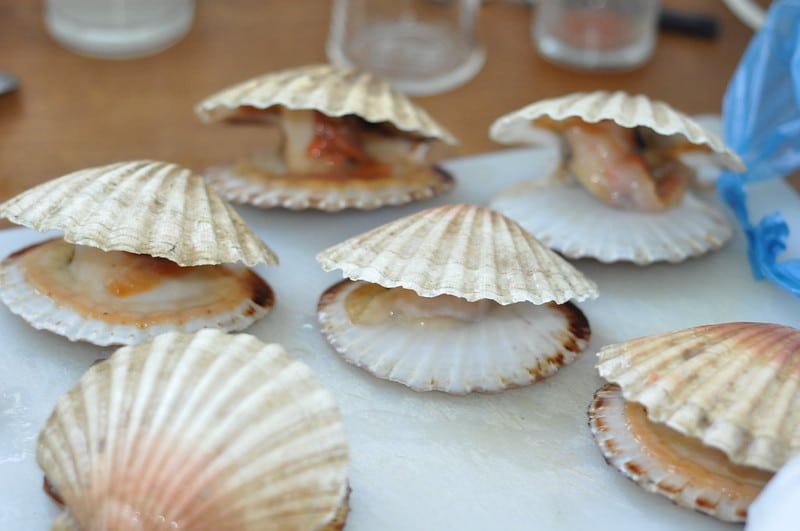The New York State Department of Environmental Conversation (DEC) has detected a protozoan parasite in a sample of Peconic bay scallops from the waters around Long Island. This is the first time this parasite has been detected in New York. The DEC believes this parasite is responsible for mass die-offs of adult scallops recorded in 2019 and 2020. While the parasite is not dangerous to humans, its recent toll on bay scallops has been devastating to this locally significant fishery.
—
Every winter, baymen ply the waters around New York’s Long Island to harvest the iconic Peconic bay scallops. The scallops are cousins of the clam and have a unique biology: they are functional hermaphrodites, releasing both eggs and sperm during a single spawning session. Adults also have the ability to “swim” by clapping their two valves to expel streams of water that propel them away from predators. Harvesting is difficult, physically taxing work that supports livelihoods during otherwise slow fishing months, and the haul is eagerly awaited by seafood aficionados.
Prior to the catastrophic die-offs, bay scallops aggregated across Long Island had a dockside value of $1.6 million and employed a multitude of fishermen, who have now been compelled to find other work in an economy already challenged by COVID-19. The financial plight of baymen, combined with the ripple effect of an economic downturn and a changing fishing environment on Long Island, is not new. Singer/songwriter Billy Joel, himself a native Long Islander, immortalised the baymens’ struggle with Long Island’s changing marine health in his popular 1989 song, “Downeaster Alexa.” The reasons for declining marine animal populations have historically included overfishing, indiscriminate fishing techniques, and now, climate change and invasive species.
You might also like: ‘The World is Not Prepared for Climate Change’- UN Environment Chief
In an effort to prevent the scallop die-off from becoming an annual event, the DEC is working with Stony Brook University’s Marine Animal Disease Laboratory to “investigate environmental factors that promote disease development of the parasite and monitor its geographical extent,” according to Commissioner Basil Seggos in a press release. At the time of publication, the research has determined that the parasite causes damage to the renal tubules of the scallops’ kidneys, extensive enough to result in the scallops’ death. The Commissioner further acknowledged that “the discovery of a protozoan parasite in bay scallops from Peconic Bays represents a significant threat to this commercially important fishery.” Estimates put the mortality rate at 90% throughout the scallops’ habitat, and at 100% in some particularly hard-hit areas.
In addition to the damage this invasive parasite is causing, experts such as Dr. Stephen Tettlebach, a shellfish ecologist at Cornell Cooperative Extension, believe that the die-off is also linked to climate change, specifically increasing water temperature combined with low dissolved oxygen levels. Bay scallops are known to be sensitive to high water temperature; the theory is that rising water temperatures have made adult scallops especially physiologically susceptible to the parasite, contributing to the high mortality rate. According to Dr. Tettlebach, 2019 set a record for the warmest water temperatures in the last five years, topping 29 degrees Celsius.
Concerned that the last two years are the beginning of a pattern, in December 2019, New York Governor Andrew Cuomo sent a letter to the United States Secretary of Commerce requesting a federal disaster declaration for the bay scallops. The NYSDEC is currently working directly with the National Oceanic and Atmospheric Administration (NOAA) Fisheries department to provide additional information to support the disaster determination. In addition, as part of his 2020 State of the State report, Governor Cuomo proposed the Restore Mother Nature initiative, touted as the nation’s most aggressive program for restoring habitats and controlling floods. This initiative would double funding of New York’s existing artificial reef programme and other shellfish restoration initiatives. Funding would come from the Governor’s $3 billion environmental bond act proposal and a separate $300 million earmarked to the state Environmental Protection Fund.
Importantly, juvenile scallops do not appear to be part of the die-off, so optimism remains that sufficient numbers will survive to reproduce in 2021. This news is promising. Expanding our understanding of how this parasite proliferates, appropriating public funds to protect the scallops, and recognising the impact of changing environmental factors on these vulnerable creatures, will be key to protecting this locally vital marine resource.
Featured image by: Flickr

















